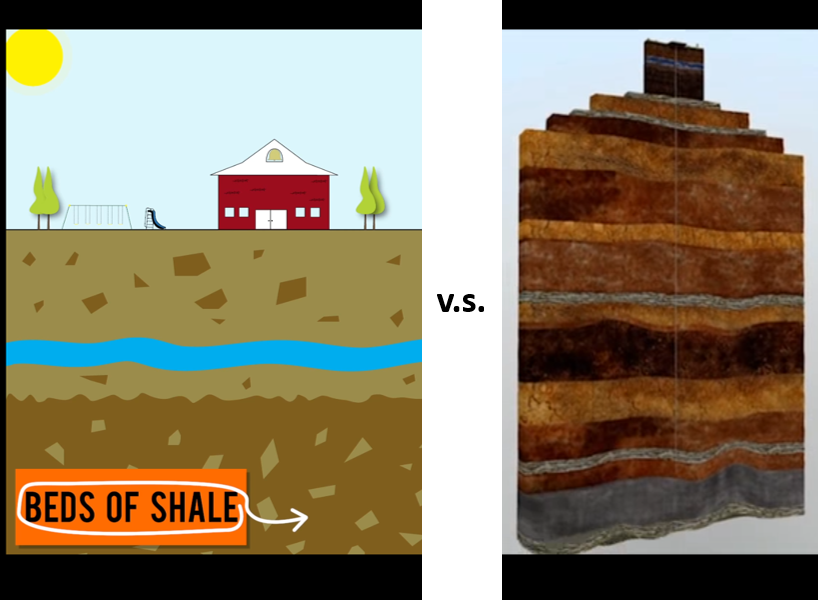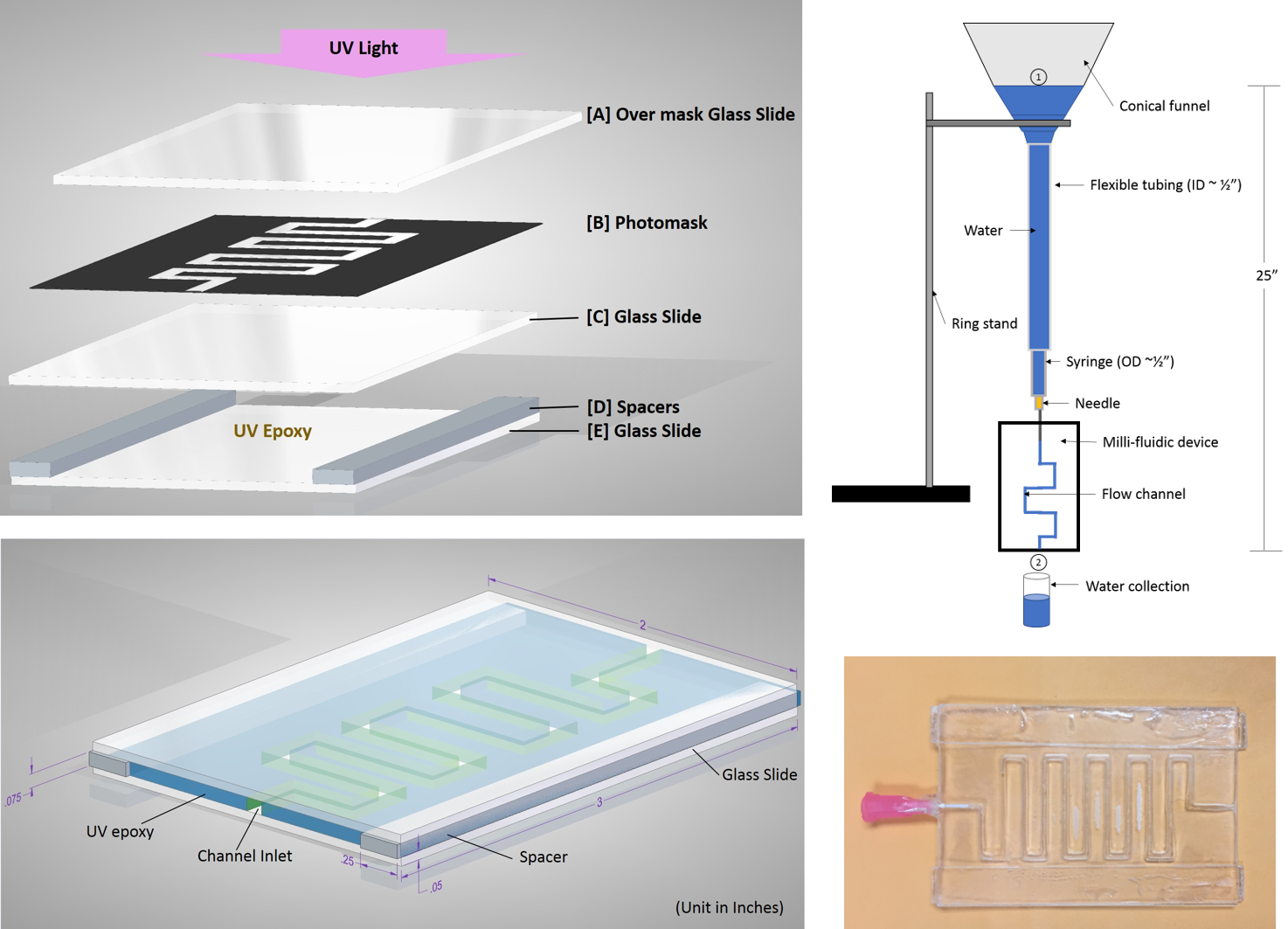Engineering Education Research
In addition to striving to be an effective educator in the classroom, I work on projects related to engineering education research as a member of the Montana Engineering Education Research Center (MEERC). Examples of different projects include:
- Societal Topics within Technical Engineering Courses - 'Frack Attack'
- Labs in the Classroom
- Design throughout the Curriculum - Integrating Senior Design in Freshman-Junior level courses
Frack Attack
Fluid Mechanics at Montana State University covers a range of topics including fluid properties, hydrostatics, the Bernoulli equation, the Mechanical Energy balance, pumps and pump sizing, packed beds, Navier-Stokes equations, COMSOL multiphysics, and an introduction to advanced topics like multi-phase flows and non-Newtonian fluids. However, topics engineers may deal with often include more facets than the technical alone. To bring broader perspectives on 'big problems' into the classroom, we have developed a 75 minute module called 'Frack Attack' where students analyze hydraulic fracturing from five perspectives: economics, environment, society, technology, and politics. Led by Dr. Paul Gannon, the students are presented two videos on the topic, one from industry and one from a science advocacy group. A quick discussion on the differences and potential biases in each is discussed and one example related to the how the scale of the operations is presented below.

Students work in groups in these theme areas to collect information from online sources during class, and then use this information to inform a class discussion. A follow-up homework focuses pump sizing ('core' course content) related to fracking operations. Our results show the approach does not skew students toward supporting or opposing fracking, and they self-report its effectiveness in their learning. An accepted paper in Chemical Engineering Education will be posted in the Summer 2018.
Labs in the Classroom - Millifluidic Devices and the Mechanical Energy Balance
Labs often occur in the first and final year of the engineering curriculum. To utilize some of the benefits of labs in terms of student learning, we utilized a millifluidic device framework so students could perform labs during a 75 minute class period. An example of the setup is shown in the pictures here.

The devices are made in-house with support from the Montana Microfabrication Facility. Students use tubing and funnels to set a driving force, and the flow rate of collected water can be measured. With this information, students can assess friction in the system, such as that caused by bends. These efforts are detailed in an ASEE paper.
Senior Design in Freshman-Junior level Courses
The Capstone Design course is represents a summation of the previous courses and the first detailed design within the major. To promote design throughout the curriculum, the design projects are being integrated into multiple classes that occur earlier in the curriculum. For instance, Seniors have presented to Freshmen in ECHM 100, enhancing the Seniors' communication skills while promoting a broader understanding of the major to the first-year students. Technical aspects have also been incorporated into classes like Fluid Mechanics and Heat Transfer, where students check the accuracy of the Seniors' technical designs of pumps and heat exchangers. This affords the underclassmen a chance to apply material they are recently learning while getting a better sense of the overall curriculum. We hope to continue these efforts and facilitate more interactions to enhance engineering identity formation and perhaps increase a sense of community in a department with over 600 students.
Papers and conference presentations
- Davis*, E. Papendorf, S. Windchief, S. Morris, P.Gannon, R. Anderson, Tipi Flow Patterns: Experimental Lab-Scale Fluid Visualization WIP, ASEE PNW Section Conference, March 2024.
- [Workshop] Davis*, E. Papendorf, S. Windchief, S. Morris, P.Gannon, R. Anderson, Tipi Building – A (WIP) Workshop Proposal, ASEE PNW Section Conference, March 2024.
- [Poster] Davis*, S. Windchief, E. Papendorf, S. Morris, P.Gannon, R. Anderson, IEFA Essential Understandings & Tipi Fluid Mechanics WIP, ASEE PNW Section Conference, March 2024.
- [Poster] Cummins*, S. Windchief, S. Morris, R. Anderson, Flow Patterns in Teepees: Understanding Fluid Dynamics in Traditional Shelters, 76th Annual Meeting of the APS Division of Fluid Dynamics, November 2023.
- Anderson, E. Papendorf*, S. Windchief, Airflow through tipis - Indigenous ways of knowing and computational fluid dynamics, Canadian Engineering Education Association, Summer 2023, Kelowna BC.
- Windchief, E. Papendorf*, R. Anderson, Indigenous ways of knowing in the engineering classroom via computational and experimental fluid dynamics, 2022 Northern Rocky Mountain Educational Research Association, October 2022.
- [Abstract accepted] Richards, R. Anderson, C. Myers, “Formation of engineering identity in second year engineering students through an intervention utilizing senior capstone design projects”, 128th ASEE Annual Conference and Exposition, 2021.
- Gannon, R. Anderson, C. Plumb, D. Hacker, K. Shephard, Engineering faculty views on sustainability and education research: survey results and analyses, The Int. Journal of Engineering Education, Special Issue – Ethics, Social Responsibility and Sustainability in Engineering Education (2021) 611-620.
- Richards, R. Anderson, C. Myers, “Work in Progress: Formation of an engineering identity in first-year students through an intervention centered on senior design projects”, 127th ASEE Annual Conference and Exposition, June 2020.
- Gannon, R. Anderson, C. Plumb, D.J. Hacker, “Frack Attack”: An engaging classroom activity to integrate sustainability, Chemical Engineering Education 52 (2018) 226-231.
- P. Gannon, R. Anderson, C. Plumb, “Research initiation: effectively integrating sustainability within an engineering program: project accomplishments”, 125th ASEE Annual Conference and Exposition, June 2018, Paper ID #22125.
- R. Anderson, P. Gannon, C. Plumb, “Sustainability within technical engineering curriculum: a hydraulic fracturing module in fluid mechanics”, Canadian Engineering Education Association, June 2018, Paper #96.
- R. Anderson, A. Richards, “WIP: Building the undergraduate chemical engineering community by involving capstone design students in undergraduate courses”, 125th ASEE Annual Conference and Exposition, June 2018, Paper ID #22880.
- R. Anderson, P. Himmer, T. Akmal, “Work in Progress - Group laboratory experiment during lecture in an undergraduate fluid dynamics class: increasing student learning and communication skills”, 125th ASEE Annual Conference and Exposition, June 2018, Paper ID #23263.
- Miller, C-H. Huang, T. Akmal, R. Anderson, P. Himmer, “Fluidic channels in the classroom: fabrication and integration in fluid mechanics”, 124th ASEE Annual Conference and Exposition, June 25-28, 2017, Paper ID #19770.
- Gannon, R. Anderson, C. Plumb, “Research Initiation: Effectively integrating sustainability within an engineering program”, 124th ASEE Annual Conference and Exposition, June 25-28, 2017, Paper ID #18117.
- Gannon, R. Anderson, J.W. Spengler, C. Plumb, “Exploring contemporary issues in sustainable energy”, 122nd ASEE Annual Conference and Exposition, June 14-17, 2015, Paper ID # 12177.
- B. Kubilius, R.S. Tu, R. Anderson, Integrating the ChE Curriculum via a recurring laboratory, Chemical Engineering Education 48 (2014) 221-230.
- Karim, R. Anderson, R. Hall, “The development of a teaching assistant training program in applied science: design and implementation”, 118th ASEE Annual Conference and Exposition, June 26 - 29, 2011, AC 2011-2569.
